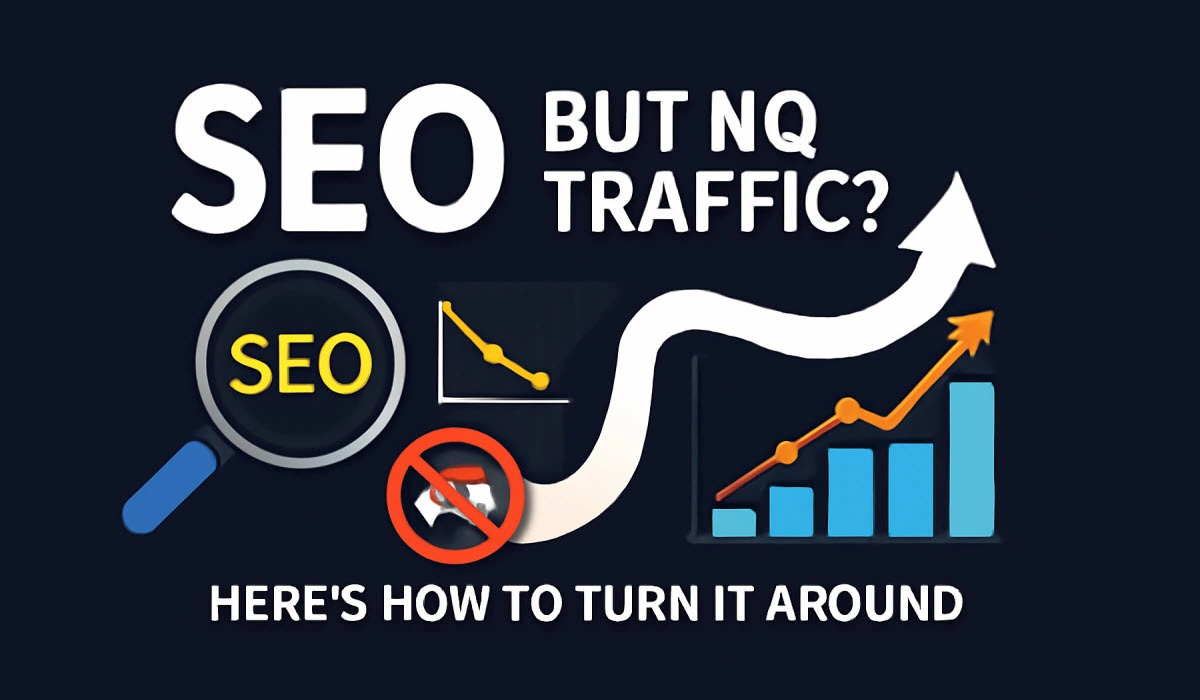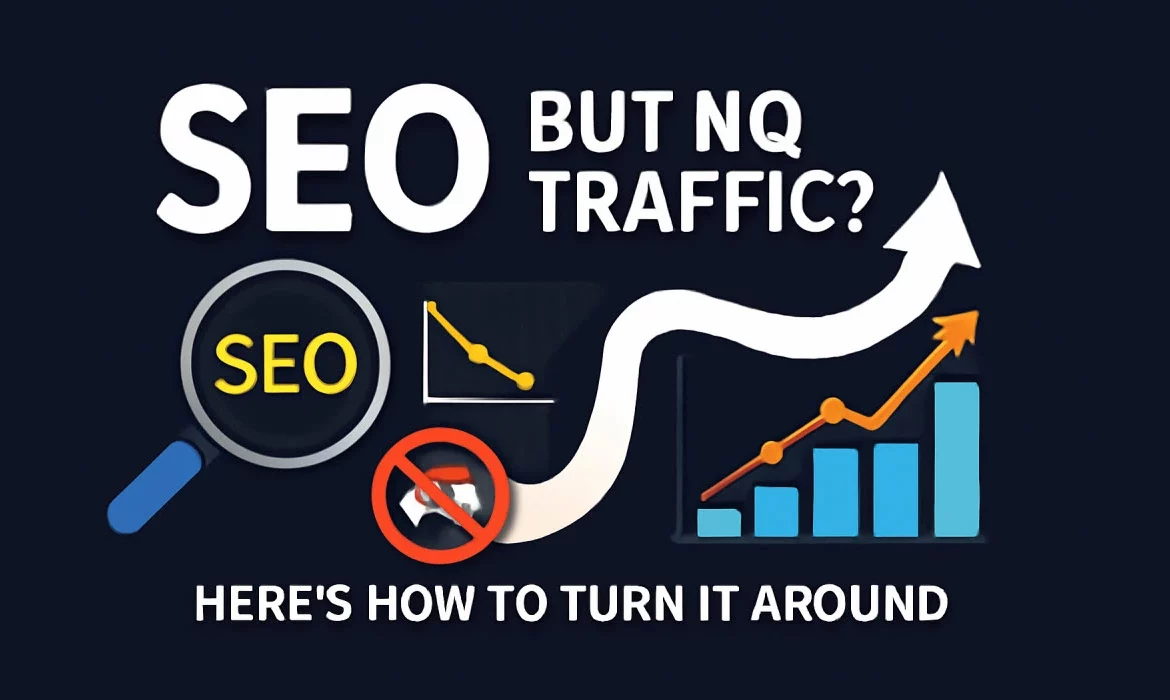
Have you ever poured your heart into SEO—optimizing your website, creating content, building backlinks—only to see your traffic stubbornly refuse to budge? I’ve been there. Early in my digital marketing journey, I faced that exact frustration: all the right SEO moves on paper but zero real visitors. It was like shouting into a void. That struggle pushed me to dig deeper, test harder, and rethink my whole approach. If you’re battling SEO but no traffic, buckle up—because I’m about to share everything I learned to turn it all around. And if you want a quick primer on what SEO really means, check out this insightful video to get started.
The SEO Traffic Struggle: A Real-Life Story
When I first launched my agency’s website, I was confident that SEO would be the magic bullet. I did keyword research, optimized meta tags, and even wrote blogs packed with keywords. But after weeks, the traffic was almost non-existent. It wasn’t just disappointing—it was baffling. I realized SEO isn’t just about ticking boxes; it’s about creating an ecosystem that users and search engines both love. After some trial and error, including consulting SEO pros and analyzing my site’s flaws, I began to see steady growth. This journey was eye-opening and helped me craft strategies that work in the real world, not just theory. If you want to learn practical tips on fixing your SEO issues, this video guide helped me a lot along the way.
Facts and Figures That Matter
Did you know that 93% of online experiences begin with a search engine? (Source: Search Engine Journal). Yet, 75% of users never scroll past the first page of search results (Source: HubSpot). This means your SEO efforts must push you onto page one—and keep you there. Websites that load in less than 3 seconds see an average bounce rate of 9%, compared to 38% for sites loading over 5 seconds (Source: Google). These stats highlight that SEO isn’t just keywords; it’s about user experience, speed, and authority.
Challenges in SEO Traffic: Why Your Efforts Might Be Falling Short
Generating consistent SEO traffic is often more challenging than it seems. Many businesses invest time and resources into SEO but don’t see the traffic growth they expect. This happens because SEO success depends on a combination of factors, and neglecting any one can cause your efforts to fall short. Common challenges include poor keyword targeting, technical issues like slow site speed or broken links, lack of quality content that aligns with user intent, and weak backlink profiles. Additionally, ignoring mobile optimization or failing to adapt to evolving search engine algorithms can drastically limit your reach. Without a comprehensive, data-driven strategy that continuously monitors and adjusts to these variables, your SEO traffic will struggle to grow. Understanding these obstacles is the first step to diagnosing where your strategy may be failing and taking actionable steps to turn it around.
What Causes Faulty SEO? Here’s What You Need to Know
SEO isn’t magic—it’s a strategic blend of art and science. When your SEO efforts don’t bring traffic, it’s often because some fundamental pieces are missing or misaligned. Let’s unpack the most common reasons your SEO might be falling short and how you can fix each one.
1. You Overlooked the SEO Basics
Successful SEO starts with being relevant—your content must genuinely satisfy what users are searching for. Google calls this being customer-centric. If your website doesn’t deliver what visitors want, no amount of technical tweaking will help. Along with relevance, you must show authority by publishing valuable, problem-solving content. Lastly, your site needs to be user-friendly: visitors want quick, easy access to the answers they seek.
What you can do:
- Pick a strong domain name that reflects your brand or niche.
- Choose reliable web hosting to ensure fast, consistent site performance.
- Create a seamless user experience by designing intuitive navigation and clean layouts.
- Build a logical site structure that helps both users and search engines find information easily.
2. Technical SEO Issues Holding You Back
Technical glitches can sabotage even the best SEO strategy. Things like robots.txt and sitemap errors can block search engines from crawling your site properly. With Google’s shift to mobile-first indexing, your site must perform well on mobile devices. Slow loading speeds and lack of HTTPS security compliance also harm rankings and user trust.
What you should do:
- Regularly audit and fix your robots.txt and sitemap files.
- Ensure your website is fully responsive and optimized for mobile users.
- Use tools like Google PageSpeed Insights to boost loading times.
- Secure your site with HTTPS and keep security certificates up to date.
3. Ignoring On-Page SEO Fundamentals
Your content quality and on-page elements have a direct impact on rankings. Poorly written or thin content fails to engage users or meet search intent.
How to fix:
- Produce high-quality, informative content tailored to what your audience wants.
- Optimize title tags and meta descriptions—keep titles under 60 characters and descriptions concise yet compelling (under 120 characters).
- Avoid keyword stuffing; use your primary keywords naturally in metadata.
- Use header tags (H1, H2, H3) to structure your content clearly.
To further boost engagement: - Use heatmap tools like HotJar to analyze user behavior and identify drop-off points.
- Regularly update and refresh older content by adding new insights or multimedia.
- Include clear calls to action and smart internal linking to guide visitors and improve crawlability.
4. Neglecting Off-Page SEO and Backlinks
Backlinks act as votes of confidence from other sites, signaling your authority to Google. But not all backlinks are equal.
What to watch for:
- Links from websites relevant to your industry carry more weight.
- Prioritize backlinks from high domain authority sites.
- Focus on natural, earned links rather than purchased or spammy ones.
Also, optimize for local SEO:
- Claim and optimize your Google Business Profile.
- Ensure your business information is consistent across all platforms.
- Encourage and respond to customer reviews.
- Use local keywords and schema markup to boost visibility in local search.
5. Targeting the Wrong Keywords
Choosing keywords without research or intent alignment means attracting the wrong traffic—or none at all.
How to fix:
- Use keyword tools to find terms your ideal customers actually search for.
- Consider search volume, competition, and user intent before selecting keywords.
6. Not Using a Data-Driven SEO Approach
SEO requires constant measurement and refinement. Ignoring data means flying blind.
What you should do:
- Track metrics like session duration, bounce rate, and page clicks.
- Monitor content performance and organic traffic sources.
- Set up alerts for 404 errors and broken links.
- Use dashboards to segment and analyze traffic for better decision-making.
- Stay on top of trends and algorithm updates to keep your strategy fresh.
7. Falling Behind on SEO Trends
SEO is always evolving. The rise of AI-powered search (like ChatGPT) is reshaping how people find content.
How to keep up:
- Write content in a natural, conversational tone that your audience uses.
- Create long-form, authoritative pieces without keyword stuffing.
- Use clear headings and structured content to help AI tools understand your pages.
8. Unrealistic Expectations and Impatience
SEO isn’t instant. Expecting overnight success leads to frustration and poor decision-making.
Remember:
- SEO results typically take months.
- Consistent effort and optimization pay off over time.
9. Ignoring Competitor SEO Strategies
If you’re not watching your competitors, you’re missing key opportunities.
How to keep up:
- Identify direct and organic competitors.
- Use tools like SEMrush to analyze their keywords, backlinks, and content strategy.
- Adapt and improve your SEO plan based on what’s working in your niche.
If you want to explore professional SEO services that can fix these issues, take a look at this detailed guide by EvenDigit.
Conclusion
SEO success demands a holistic, data-driven approach—from technical setup and compelling content to authoritative backlinks and competitive analysis. If your SEO isn’t working, it’s time to audit your strategy and fill the gaps. Remember, SEO is a marathon, not a sprint. With patience and persistence, you’ll see your traffic rise. And if you need expert help, let EvenDigit guide your SEO journey toward traffic growth and lasting results. Start by understanding what SEO really means and take the first step toward growth today.
FAQs
How can I increase my SEO traffic?
Focus on quality content, technical optimization, and building authoritative backlinks. Use data to refine your strategy continuously.
Why doesn’t SEO work?
SEO fails when basics are ignored, technical errors block indexing, or content doesn’t meet user intent. Consistency and strategy matter.
How to get 100% SEO?
SEO is an ongoing process. Aim for comprehensive optimization, but remember no one can guarantee 100% SEO success due to search engine algorithms.
Does SEO drive traffic?
Yes, when done right, SEO drives targeted organic traffic that converts better and sustains long-term growth.




